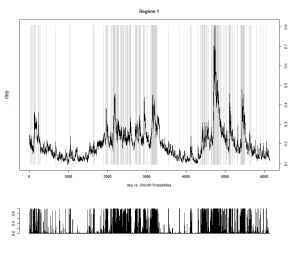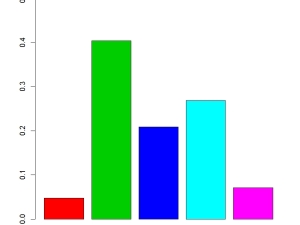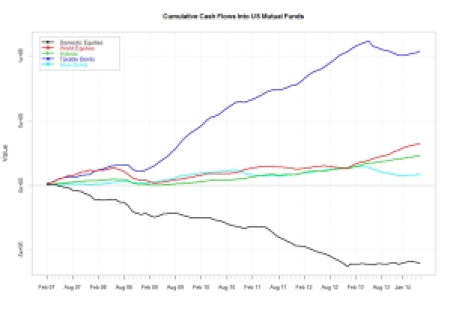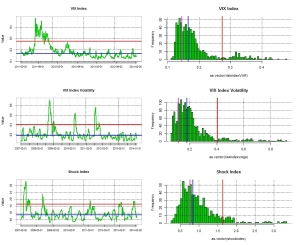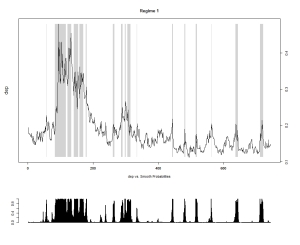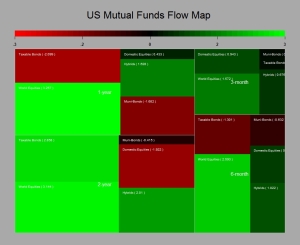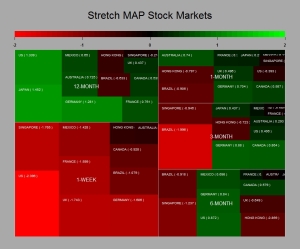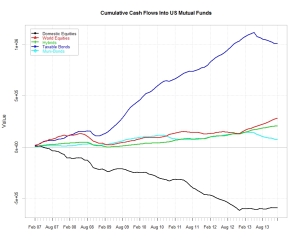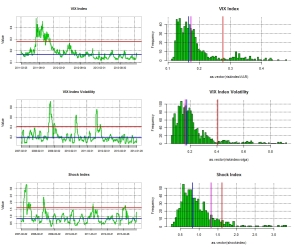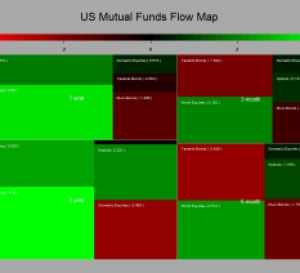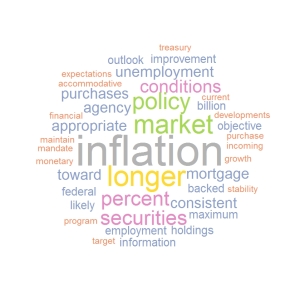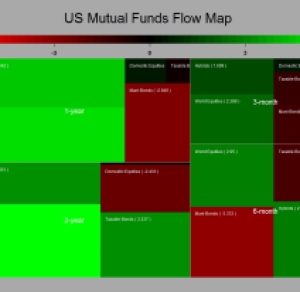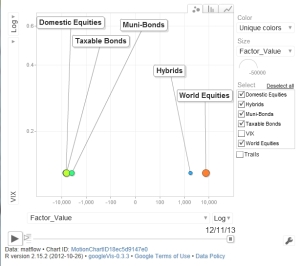The below is a generic asset allocation report produced from the perspective of a UK investor. I use the Barclay UK Gilts all maturities index, the MSCI World ex UK and the MSCI UK Gross indices (i.e dividends re-invested) as proxies for bonds and equities holdings. As time goes I will add a few more asset buckets such as EM, commodities and properties. So see this as a first attempt to an evolutive product.
The below charts shows the rolling 36-month return, volatility and risk adjusted return for each of the assets used in the final portfolio. Clearly equities have a higher volatility than bonds but also higher/lower localised returns highliting that timing is key in unlocking those higher returns.

The below summary performance statistics show that a UK investor would have got the best risk adjusted return by holding a broad basket of Gilts. Over the long term the returns would have been quite similar accross asset classes. However the risk as expressed by the annualised volatility of the monthly returns and the maximum drawdown would have been at it highest for equities and particularly for World Ex. UK stocks.
## Gilts World Ex UK Stocks UK Stocks ## Annualized Return 8.85 10.62 10.43 ## Annualized Standard Deviation 6.55 16.00 15.96 ## Annualized Sharpe Ratio (Rf=0%) 1.35 0.66 0.65 ## Worst Drawdown 11.42 52.51 44.04
In the following I use a mean-variance model to compute the weights of the portfolio that maximises the information ratio on the efficient frontier.The model is optimised for “long only” and weights adding to one constraints. I use a rolling window of 36-month to estimate the returns, volatility and correlation input fed into the Markovitz model. The use of a rolling window implies that the momentum effect in the input is captured by the optimisation. Therefore if an asset becomes more attractive through time in terms of its risk adjusted return and/or diversification potential its participation into the final portfolio should increase and vice versae.
The two charts below show how the optimised portfolio weights have changed throughout time and also what were the weights at the end of the last month.

Using the above weights I then calculate the return of the portfolio for the folowing period assuming a cost of 0.25% of adjusted notional for each monthly rebalancement. The performance is compared to the return of a portfolio composed of 60% Gilts and 40% UK equities.

**Summary Performance Statistics **
## Benchmark 60/40 Optimal Portfolio ## Annualized Return 8.58 8.13 ## Annualized Standard Deviation 7.86 5.90 ## Annualized Sharpe Ratio (Rf=0%) 1.09 1.38 ## Worst Drawdown 13.54 11.26
Drawdowns Table
## From Trough To Depth Length To Trough Recovery ## 1 1994-01-31 1994-05-31 1995-05-31 -11.26 17 17 5 ## 2 1990-01-31 1990-04-30 1990-11-30 -9.49 11 11 4 ## 3 1986-09-30 1986-09-30 1987-01-31 -6.06 5 5 1 ## 4 2009-01-31 2009-01-31 2009-08-31 -5.1 8 8 1 ## 5 2008-01-31 2008-06-30 2008-12-31 -5.07 12 12 6
Monthly Returns
## Jan Feb Mar Apr May Jun Jul Aug Sep Oct Nov Dec YEARLY ## 1984 1.6 -1.9 4.1 0.2 -4.4 1.7 -1.6 7.0 2.9 2.1 2.1 0.9 14.6 ## 1985 1.6 1.8 -1.1 0.7 1.4 0.2 1.1 1.8 1.2 1.0 0.8 0.8 11.3 ## 1986 -0.1 5.0 7.2 1.9 -0.2 -0.5 0.2 2.4 -6.1 1.0 0.0 3.1 13.9 ## 1987 3.6 2.9 3.2 2.2 1.3 -1.0 -1.1 -0.5 0.6 -2.3 -0.4 -0.3 8.1 ## 1988 2.9 2.0 1.0 -0.1 0.4 0.3 1.0 -1.7 2.7 1.8 -1.8 1.5 10.0 ## 1989 3.2 -0.3 0.8 0.8 0.0 0.8 3.5 0.6 -1.3 0.8 0.1 1.9 11.1 ## 1990 -3.5 -2.1 -2.5 -1.7 5.8 2.0 -0.3 -1.3 -0.8 3.9 3.0 0.3 2.8 ## 1991 3.7 1.9 1.2 0.4 0.3 0.3 2.3 1.9 2.4 0.4 -0.4 1.3 15.8 ## 1992 2.5 1.3 -2.4 4.1 2.1 -0.4 -0.2 -1.0 4.0 5.2 -1.0 2.5 16.6 ## 1993 1.3 2.2 0.8 -1.3 0.5 3.3 2.4 3.4 0.1 1.3 1.9 3.6 19.8 ## 1994 -0.1 -3.6 -3.3 -1.1 -3.7 0.5 1.4 0.9 -1.2 1.0 2.1 -0.5 -7.4 ## 1995 1.1 0.5 1.4 1.3 3.6 -2.2 2.3 1.4 0.4 1.2 3.7 1.3 15.9 ## 1996 0.9 -1.9 0.2 1.9 -0.5 1.6 -0.1 0.7 2.1 0.0 2.3 -0.9 6.3 ## 1997 2.3 1.1 -1.7 1.9 2.2 1.0 1.6 0.0 3.8 0.2 0.6 1.8 14.8 ## 1998 1.9 0.2 1.7 0.9 1.2 -0.3 0.9 3.1 3.2 0.0 3.1 2.2 18.1 ## 1999 1.1 -1.7 0.8 0.1 -1.6 -0.1 -1.0 1.2 -2.2 2.1 1.6 -0.5 -0.2 ## 2000 -1.7 1.7 1.4 0.9 0.5 0.4 0.0 0.0 0.4 1.0 1.8 0.6 7.2 ## 2001 0.5 -0.4 -0.3 -0.9 -0.6 -0.4 1.9 1.1 -0.9 3.3 -0.2 -2.0 1.0 ## 2002 1.2 -0.4 -1.5 0.7 -0.1 1.2 0.2 2.2 0.3 0.1 -0.1 1.0 4.7 ## 2003 0.3 1.0 -0.6 1.2 2.4 -0.5 -1.1 0.4 0.4 -1.4 0.4 2.4 4.7 ## 2004 -0.4 1.0 0.5 -0.7 -0.9 1.1 0.1 1.6 1.1 1.0 1.3 0.8 6.6 ## 2005 0.1 -0.1 0.3 0.9 2.3 1.6 0.0 1.1 0.3 -0.4 1.8 1.6 9.6 ## 2006 0.9 0.3 -0.6 -1.2 -0.7 0.0 1.3 0.9 0.6 1.2 0.0 -0.6 2.1 ## 2007 -1.3 1.4 -0.2 0.3 -0.3 -1.0 1.2 1.1 0.7 1.6 0.2 1.5 5.1 ## 2008 -2.0 0.3 0.2 -0.1 -1.3 -2.2 1.4 2.7 -2.3 -1.1 3.9 5.0 4.4 ## 2009 -5.1 0.2 2.7 -0.1 -0.3 0.4 0.3 4.2 0.7 -0.4 1.2 -2.0 1.6 ## 2010 0.1 0.1 1.4 0.4 1.5 0.8 0.5 4.0 0.2 -1.0 -0.8 0.6 7.7 ## 2011 -1.8 1.0 0.2 2.1 1.0 -0.6 2.7 0.5 2.4 2.4 1.7 1.6 13.2 ## 2012 0.7 -0.5 -0.6 -0.3 2.8 -0.1 1.9 0.1 -0.3 -0.6 1.1 -0.2 4.0 ## 2013 0.5 2.0 1.9 1.0 -1.1 -2.6 2.2 -2.1 0.7 1.8 -0.7 -0.6 2.9 ## 2014 0.6 1.0 0.2 0.4 1.4 -0.5 0.7 3.5 -0.9 1.3 3.3 0.8 11.8 ## 2015 4.0 -2.1 1.6 -1.1 0.6 -3.5 1.9 -1.6 0.2 0.5 0.9 NA 1.5
If you need more information or have questions about the above, feel free to contact me at pollux@argonautae.com










 The Charts below shows the distribution in percentage terms of the US$ 63Bn that have flowed into US$ Mutual funds over the last 12-month.
The Charts below shows the distribution in percentage terms of the US$ 63Bn that have flowed into US$ Mutual funds over the last 12-month.



